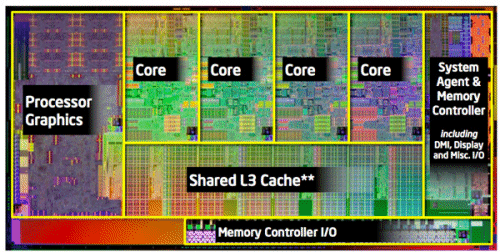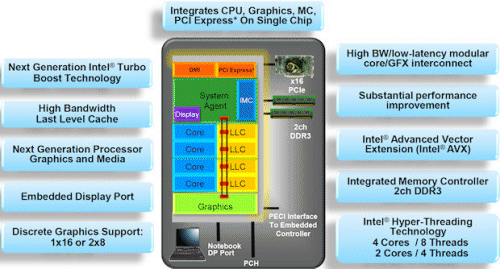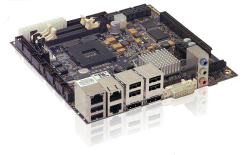
The Intel Core i3/i5/i7 processors can be found on a number of higher end single-board computers in various form factors. Intel recently updated these processors and made some significant changes. The company tells me that 24 SBC manufacturers are using the 1st or second-generation Core CPUs (I have a list — e-mail me if you want it). Let’s take a look at the new second-generation chips and then find some SBCs that use them.
I’m surprised Intel didn’t attach a new name to these “second-generation” Core i3/i5/i7 CPUs with the “Sandy Bridge” internal title, because they did some pretty significant architectural changes. The most importance new feature may be the inclusion of a graphics processor. Intel did this before with Core i3 and some i5 processors, but the graphics processor was still a separate unit. Now they ore on the same silicon and tightly coupled, so unless you need high-end gamer graphics you don’t need a graphics card. And now, all three have the same graphics, unlike the first generation. And, they all have Quick Sync, a video transcoding hardware feature that provides blazing performance when converting videos to a different format.
The second generation requires a new LGA-1155 socket motherboard equipped with a QM67 or HM65 chipset so you can’t plug them into a previous-generation board. With 29 different versions of these three processors, it can get a bit confusing. They use 1333/1666 MHz DDR3 memory and have two, four, or eight cores.
Intel tags 12 versions for embedded systems:
Embedded desktop (Scalable) — i7-2600, i5-2400, and i3-2120.
Embedded mobile (Low Power) — i7-2610E, i7-2655E, i7-2710QE, i7-2715QE, i5-2510E, i5-2515E, and i3-2310E.

The i5 and i3 seem to offer the best value to me, but the i7 is the most prominent in SBCs. Just make certain the processor you select is tagged “embedded” by Intel to get 5 to 7-year life-cycle support.
The i3 is always dual core, while the i5 is dual or quad. The i3 versions do not have Turbo Boost, Virtualization, or Trusted Execution technology like all three Core i5s. Three of the i3/i5 CPUs take 35-W TDB, the i3-2120 takes 65-W (because it can run at 3.3 GHz), and the i5-2400 takes 95-W. The i5-2515 and the i3-2310 (along with i7 2610, 2655, and 2715) support memory ECC and all versions have PCIe 2.0 ports and USB 2.0.

It looks to me like there are four Platform Controller Hubs (chipsets) available for these CPUs. The B65, HM65, Q67, and QM67. The “M” types are mobile 3.9-W devices, and the other two take 6.1 W.
I thought for a moment (silly me) that all these CPUs fit in the same 1155 socket — but no, there seem to be four socket types: FCPGA988, FCBGA1023, LGA1155, and FCLGA1155. They are 31 x 24 mm or 37.5 mm square.
Tomshardware.com compared systems with the old i5 and the new i5 and the PCmark numbers went from 8,281 to 10,222 — pretty hefty jump.
A few second-generation Core i single-board computers
Congatec (www.congatec.com) offers a number of Com Express modules with Core i7 processors including the 95 x 125-mm conga-BM67 with Type 2 Pinout/Basic Form Factor which uses Core i7-2710QE 2.1-GHz (TDP 45 W) or the i5-2510E 2.5-GHz (TDP 35 W) CPUs. The card has two DDR3 sockets, six PCI Express lanes, four Serial ATA, an EIDE port optional, eight USB 2.0 ports, a PCI bus, LPC and I2 C buses, three DisplayPorts, and three HDMI I/Os.
American Portwell Technology (www.american-portwell.com) has its RUBY-D712VG2AR with second-generation Core i5 and i7 CPUs in the industrial ATX motherboard form factor. It has all the normal stuff, including up to 16 Gbytes of DDR3 and two GbE ports.
Kontron (us.kontron.com) is promising the KTQM67/mITX Mini ITX board uses a second-generation -i7-,-i5, and -i3 two- and four-core CPUs and the QM67 chipset. It provides high-performance graphics with Display Port, LVDS, and DVI I/O and six SATA ports, 14 USB 2.0, and GbE I/O and Intel AMT 7.0 support. Kontron will also have a FLEX-ATX motherboard version.

The Kontron KTQM67/mITX Mini ITX board uses a second-generation -i7-,-i5, and -i3 CPU.
MEN Micro (www.men.de) provides the F21P 3U CompactPCI card with a Core i7-2715QE and a 32-bit/33-MHz bus. It has four USB 2.0 ports, four PCI Express x1 links, two SATA 3-Gbit/s and two SATA 6-Gbit/s interfaces as well as one GbE port on the J2 rear I/O connector. The card has soldered in DDR3. The standard I/O available at the front panel includes VGA, two PCIe-driven GbE ports, and two USB 2.0 ports.
Extreme Engineering Solutions (www.xes-inc.com) has the XPedite7470 3U VPX-REDI single-board computer based on the second-generation Core i7 CPU and QM67 chipset. With up to 8 Gbytes of DDR3 ECC, two PCI Express Fat Pipe P1 interconnects, and two Gigabit Ethernet ports, the card fits high-bandwidth and processing-intensive military and avionics applications. Floating-point-intensive applications such as radar, image processing, and signals intelligence will benefit from Advanced Vector Extensions (AVX) in the Core i7.
GE Intelligent Platforms (defense.ge-ip.com/products/3576) offers the SBC324 VPX card with Core i5 and i7 options. This SBC has up to 8 Gbytes of 1333 MHz RAM, up to 32 Gbytes of NAND flash, x4 and x16 PCIe connections, USB, GbE, UARTs, SATA, HD audio, and –40° to 85°C operation. GEIP has a number of other second-generation SBCs.
Curtiss-Wright Controls (www.cwcembedded.com) has the VPX3-1256 3U VPX card using the Core i7-2715QE quad-core that features the high-bandwidth small form factor advantages of the 3U OpenVPX board architecture. The board has up to 16 Gbytes DDR3 of and a 16-Gbyte flash drive. With a wide complement of I/O, Gen2 PCIe fabric, SRIO, and XMC expansion, the SBC satisfies demanding fielded rugged applications.
Advertisement
Learn more about Electronic Products Magazine





